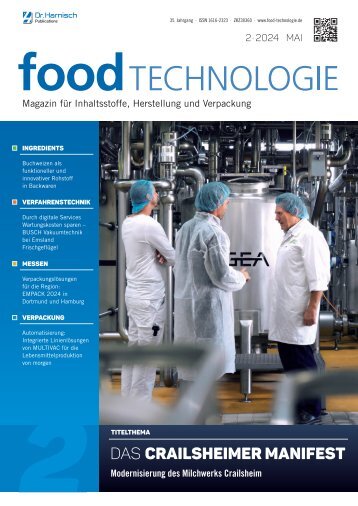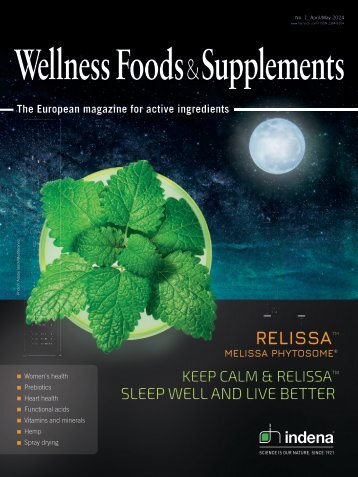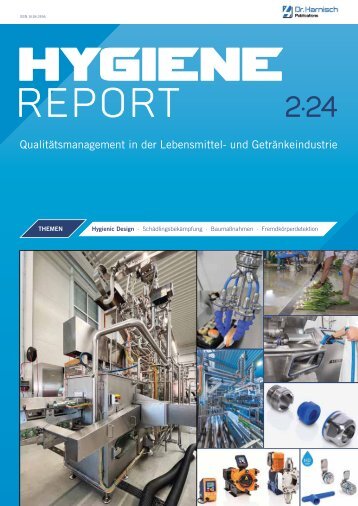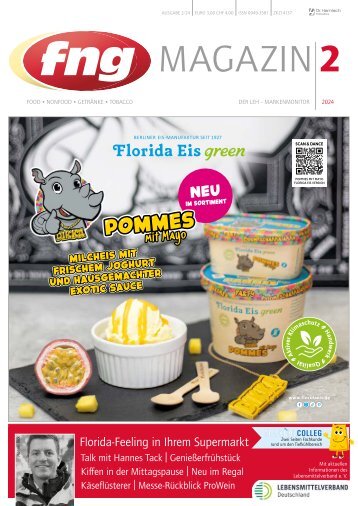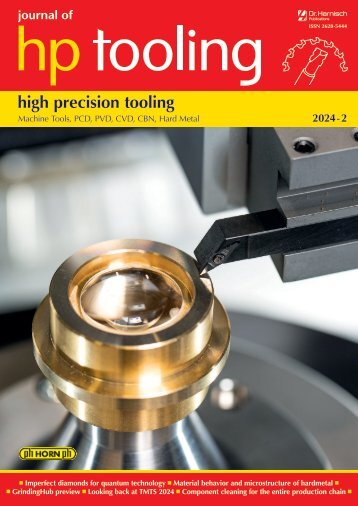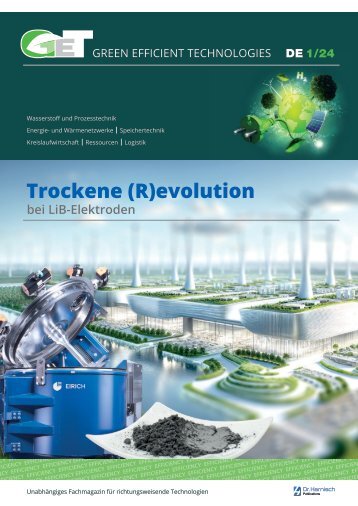Wellness Foods & Supplements 3/2020
- Text
- Harnischcom
- Supplements
- Foods
- Wellness
- Clinical
- Salts
- Protein
- Dairy
- Vaginal
- Products
- Yogurt
- Mineral
- Calcium
- Magnesium
Minerals Photo ® :
Minerals Photo ® : Adobe Stock/nd3000 Magnesium Carbonate – Oldie but Goldie Physiology and requirements Without the vitally important element Magnesium, it is impossible for living cells to fulfill their manifold physiological functions. Magnesium is of central importance in almost all metabolic processes and essential for the neuromuscular and cardiovascular system. A sufficient supply of Magnesium is important throughout lifetime – especially during pregnancy, childhood and old age. People in these phases of life and people with certain diseases have an increased need for Magnesium. The fortification of foods with Magnesium Carbonate or the use of food supplements can prevent a deficiency. With a Magnesium content of approx. 25 %, Magnesium Carbonate is an ideal source of Magnesium. It can be a good option for the prevention and therapy of a variety of different diseases. In Europe, the Nutrient Reference Value (NRV) for the daily intake of Magnesium is 375 mg/d for adults. It is advantageous to have a continuous supply with Magnesium throughout the day. Magnesium Carbonate is an inorganic Magnesium Salt and is also known as the Magnesium Salt of carbonic acid. The natural form of Magnesium Carbonate (magnesite/ bitter spar/magnesia alba) is beside Dolomite the most important Magnesium mineral on earth. Described and mostly naturally occurring forms of Magnesium Carbonate are, among others: Variations Chemical Formula Assay Magnesite MgCO 3 28.8 % Mg, 71.2 % Carbonate Barringtonite MgCO 3 *2H 2 O 20.9 % Mg, 51.6 % Carbonate, 27.5 % Water Nesquehonite MgCO 3 *3H 2 O 18.4 % Mg, 45.4 % Carbonate, 36.3 % Water Lansfordite MgCO 3 *5H 2 O 14.8 % Mg, 36.5 % Carbonate, 48.7 % Water Artinit Mg 5 (OH) 2 (CO 3 ) 4 *3H 2 O 27.5 % Mg, 54.4 % Carbonate, 18.1 % Water/Hydroxide Hydromagnesite Mg 5 (OH) 2 (CO 3 ) 4 *4H 2 O 26.6 % Mg, 52.5 % Carbonate, 21.0 % Water/Hydroxide Dypingite/Giorgiosite Mg 5 (OH) 2 (CO 3 ) 4 *5H 2 O 25.7 % Mg, 50.7 % Carbonate, 23.7 % Water/Hydroxide Prokovskite Mg 2 CO 3 (OH) 2 34.6 % Mg, 42.7 % Carbonate, 22.8 % Hydroxide 20 No. 3 November/December 2020
Minerals Dr. Paul Lohmann ® produces a highpurity and extremely versatile Magnesium Carbonate for miscellaneous applications. It meets the purity requirements of Ph. Eur., USP, FCC and E 504 and offers an excellent stability. Customized requirements can be taken into account during production, as well. purity and nutritional value. Dr. Paul Lohmann ® has developed qualities that meet extra low heavy metal limits. Of course, our Magnesium Carbonate is also Kosher/Halal. The high quality standards and the focus on approval in pharmaceutical applications have proven their worth: Dr. Paul Lohmann ® was one of the first manufacturers of Magnesium Carbonate to receive the General properties and documentation Name: Magnesium Hydroxide Carbonate; Magnesium Carbonate, basic Formula: approx. 4MgCO 3 *Mg(OH) 2 *5H 2 O Molecular weight: approx. 485 g/mol Appearance: white powder Odor: neutral Flavor: sandy, neutral Solubility (20 °C): < 1 g in 100 ml water pH (1% Suspension): approx. 10 (basic) Assay Magnesium (Mg): approx. 25 % Monographs of the European and American Pharmacopoeias (Ph. Eur., USP) describe Magnesium Carbonate as a basic Magnesium Carbonate containing crystalline water, which contains a certain amount of alkaline earth oxide, calculated as Magnesium Oxide. The Ph. Eur. also distinguishes a light and a heavy quality of Magnesium Carbonate. It is a white powder or granules. The bioavailable Magnesium Salt is almost insoluble in water but easily soluble in combination with acids, releasing CO 2 . In contrast to soluble Magnesium Salts, an up to five times lower amount of the Mineral Salt is needed to obtain the same amount of Magnesium in the final product. This minimizes costs and enables various positioning possibilities in the field of food supplements, at the same time. Magnesium Carbonate is a fine white powder and available in different types. Depending on the application, an extra light (approx. 65 g/l) or extra heavy quality (500 g/l) can be used. As granules, it is ideal for direct compression to tablets. In the GMP and DIN EN ISO certified production facilities, Magnesium Carbonates are produced which meet the highest possible quality criteria in terms of product safety, certificate of suitability (CEP/CoS) for its product as an active pharmaceutical ingredient (API) according to the European Pharmacopoeia from the European Directorate for the Quality of Medicines (EDQM). For the submission of pharmaceuticals to the health authorities, a detailed documentation of the active ingredient is required. In order to simplify this for customers, Dr. Paul Lohmann ® provides the corresponding CEPs (Certificate of Suitability to the European Pharmacopeia) for both light and heavy quality. Manufacturing Seventy percent of the world’s supply of Magnesium raw material is mined and processed in China. However, due to its sustainable orientation and extremely high purity requirements, Dr. Paul Lohmann ® has always used sources from European regions. Partnerships with mining companies, responsible mining and an active recultivation and renaturation program are the focus of attention. Environmental protection and the certainty to process raw materials of the highest quality requirements, allow us to guarantee that Magnesium Carbonates with the highest quality are produced in a unique synthesis process. In a special manufacturing process, different grades of Magnesium Carbonate are produced at the two production sites in northern Germany under strict safety and quality requirements. This is a continu ous process with maximum precision. The Magnesium Carbonate basic ensures the highest purity in the final product. By varying the manufacturing conditions, products with very different bulk densities can be obtained, and the purity of the individual No. 3 November/December 2020 21
- Seite 1: No. 3, November/December 2020 www.h
- Seite 4 und 5: Contents Health Convenience Food Fo
- Seite 6 und 7: Oils and fats Photo © : 123rf/jirk
- Seite 8 und 9: Oils and fats sive “key figure”
- Seite 10 und 11: Functional sugars Photo © : Jennew
- Seite 12 und 13: Nutrition and ageing Photo © : Ado
- Seite 14 und 15: Nutrition and ageing demineralizati
- Seite 16 und 17: Nutrition and ageing Proferrin ® ,
- Seite 18 und 19: Energy and endurance system is conn
- Seite 22 und 23: Minerals Health Claims Magnesium co
- Seite 24 und 25: Women‘s health Probiotics for wom
- Seite 26 und 27: Women‘s health How can oral probi
- Seite 28 und 29: Clinical trials Photo ® : Adobe St
- Seite 30 und 31: Clinical trials methods; and the sa
- Seite 32 und 33: Fortified dairy alternatives Minera
- Seite 34 und 35: Fortified dairy alternatives Dairy
- Seite 36 und 37: Fortified dairy alternatives theref
- Seite 38 und 39: Fortified dairy alternatives instea
- Seite 40 und 41: Dairy products lactose digestion”
- Seite 42 und 43: Dairy products EPILAC premium yogur
- Seite 44: Come and see for yourself: www.harn
Unangemessen
Laden...
Magazin per E-Mail verschicken
Laden...
Einbetten
Laden...








































